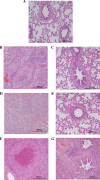Elastase-dependent live attenuated swine influenza A viruses are immunogenic and confer protection against swine influenza A virus infection in pigs
- PMID: 19625412
- PMCID: PMC2748057
- DOI: 10.1128/JVI.00926-09
Elastase-dependent live attenuated swine influenza A viruses are immunogenic and confer protection against swine influenza A virus infection in pigs
Abstract
Influenza A viruses cause significant morbidity in swine, resulting in a substantial economic burden. Swine influenza virus (SIV) infection also poses important human public health concerns. Vaccination is the primary method for the prevention of influenza virus infection. Previously, we generated two elastase-dependent mutant SIVs derived from A/Sw/Saskatchewan/18789/02(H1N1): A/Sw/Sk-R345V (R345V) and A/Sw/Sk-R345A (R345A). These two viruses are highly attenuated in pigs, making them good candidates for a live-virus vaccine. In this study, the immunogenicity and the ability of these candidates to protect against SIV infection were evaluated in pigs. We report that intratracheally administrated R345V and R345A induced antigen-specific humoral and cell-mediated immunity characterized by increased production of immunoglobulin G (IgG) and IgA antibodies in the serum and in bronchoalveolar lavage fluid, high hemagglutination inhibition titers in serum, an enhanced level of lymphocyte proliferation, and higher numbers of gamma interferon-secreting cells at the site of infection. Based on the immunogenicity results, the R345V virus was further tested in a protection trial in which pigs were vaccinated twice with R345V and then challenged with homologous A/Sw/Saskatchewan/18789/02, H1N1 antigenic variant A/Sw/Indiana/1726/88 or heterologous subtypic H3N2 A/Sw/Texas/4199-2/9/98. Our data showed that two vaccinations with R345V provided pigs with complete protection from homologous H1N1 SIV infection and partial protection from heterologous subtypic H3N2 SIV infection. This protection was characterized by significantly reduced macroscopic and microscopic lung lesions, lower virus titers from the respiratory tract, and lower levels of proinflammatory cytokines. Thus, elastase-dependent SIV mutants can be used as live-virus vaccines against swine influenza in pigs.
Figures








References
-
- Bach, E. A., M. Aguet, and R. D. Schreiber. 1997. The IFN gamma receptor: a paradigm for cytokine receptor signaling. Annu. Rev. Immunol. 15:563-591. - PubMed
-
- Belshe, R. B. 2004. Current status of live attenuated influenza virus vaccine in the US. Virus Res. 103:177-185. - PubMed
-
- Brown, G. B., and J. K. McMillen. 1994. MaxiVac-Flu: evaluation of the safety and efficacy of a swine influenza vaccine, p. 37-39. In Proceedings of the 25th Annual Meeting of the American Association of Swine Practitioners, Chicago, IL.
-
- Burlington, D. B., M. L. Clements, G. Meiklejohn, M. Phelan, and B. R. Murphy. 1983. Hemagglutinin-specific antibody responses in immunoglobulin G, A, and M isotypes as measured by enzyme-linked immunosorbent assay after primary or secondary infection of humans with influenza A virus. Infect. Immun. 41:540-545. - PMC - PubMed
-
- Chambers, T. M., V. S. Hinshaw, Y. Kawaoka, B. C. Easterday, and R. G. Webster. 1991. Influenza viral infection of swine in the United States 1988-1989. Arch. Virol. 116:261-265. - PubMed
Publication types
MeSH terms
Substances
LinkOut - more resources
Full Text Sources
Other Literature Sources
Miscellaneous

